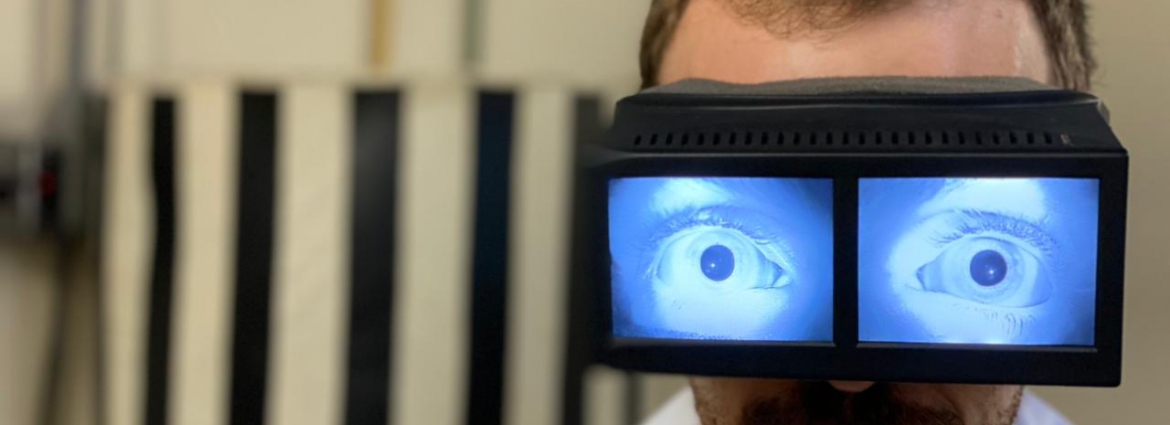Few of us are strangers to dizziness. As with pain, to equivocate about being dizzy is to cast doubt on one’s mastery of the language, not to express uncertainty about the experience. The practiced ease of first-person use, however, conceals great difficulty in defining the criteria for correct ascription from which a clear picture of the symptom can be derived, and on which close scientific investigation is inevitably premised.
By “dizzy” a patient may mean any one—or combination—of vertigo, oscillopsia, light-headedness, spatial disorientation, or unsteadiness (1). Though primarily perceptual, the experience is commonly coupled with an incapacity to act or move appropriately, creating a complex sensorimotor blend. Superimposed is an emotional reaction to the profound dysfunction the patient takes the symptoms to imply. How do we decompose so polymorphous a phenomenon; what dependencies can we establish between its components; and how do we relate them to the underlying neural substrate, in health and disease? These are the questions we wish to answer: we shall see we must be wary of the answers they immediately prompt in us, for intuition is here misleading.
The Nature of Dizziness
Prima facie, dizziness has perceptual, motor, and emotional components. Let us take each in turn.
Perceptual
It is natural to think of dizziness as an abnormal sensation of body movement in space. If so, it ought to be dependent on the integrity of a perceptual power. The blind cannot be dazzled by headlights; the deaf startled by a bang; the anosmic overwhelmed by perfume. And if the deficit is congenital, then these experiences are logically proscribed, for there is no framework within which their expression could have been learnt (2). But what sensory modality must a patient lack to be incapable of dizziness?
It cannot be the vestibular sense, for the kind of illusory head motion commonly associated with vertigo falls within the repertoire of normal motion as registered by the vestibular system alone. Moreover, inactivation—partial or complete—of the vestibular system does not attenuate or prevent dizziness (although patients may not experience rotational vertigo) but amplifies or causes it (3, 4). It cannot be vision either, for the same reasons: the visual correlates of dizziness are typically replicable without it, and though an image, especially a moving image, may trigger vertigo, closing one’s eyes does not universally abolish it (5). The experiential volume of proprioception is arguably too weak to carry so vivid an experience, but the same arguments apply in any event.
So the perceptual aspect of dizziness is not explicable by any single perceptual modality. Rather it requires the interaction of at least two, as classically illustrated by the caloric reflex test. Here artificial stimulation of the vestibular apparatus using water at varying temperatures creates a discrepancy between artificially stimulated vestibular and intact visual signals, generating nystagmus accompanied by vertigo (6). Removing visual input by closing one’s eyes attenuates the experience but does not abolish it, for proprioceptive signals remain at odds.
Examples of other multi-modal combinations are easy to give. But what is the nature of the critical cross-modal interaction? A cross-modal comparison can never be direct, for the signals of each modality are definitionally different. But we can compare the circumstances under which a given perceptual signal is obtained: here typically a coherent pattern of motion of the eyes and head. Dizziness generally arises where the associated circumstances—real or merely predicted—are discordant. Crucially, it is the mere presence of discordance—not its direction, quality, or magnitude—that evokes the experience (7). To the extent to which dizziness is perceptual it is meta-perceptual, superordinate on the sensory modalities whose discordance it registers. This places it in a unique experiential category: an indicator of the cross-modal coherence referenced to the body. We cannot easily construe it on the model of simple sensations, for its perceptual aspect is sui generis.
Motor
Any experience involving the perception of movement is bound to exhibit a motor aspect (8). Though affordance is widely assumed to be specific to the spatial properties of objects of action (9), there are no grounds for believing it must be so limited. Indeed, if action is to be responsive to the spatiotemporal continuity of the environment, affordance must extend both to the subject, and across time (10). If I erroneously perceive myself to be falling backwards, then when I make no corresponding motor response it is only because I have deliberately suppressed it in the realization the perception is illusory. Here the motor system is naturally activated downstream of an afferent signal—the movement, or suppressed movement is reactive—but its contribution to the experience need not be secondary.
Nowhere are action and perception more entangled than in the visual system. The primary objective of eye movements is to maintain a tight coherence of gaze and environmental salience over time (5). The global, background shift implied by a perception of self-motion—illusory or real—cannot but activate the oculomotor system, which must act automatically to stabilize an image that would otherwise become uninterpretable (11). Indeed, it is on the oculomotor system that the cross-modal comparison between the visual and the vestibular depends. The vestibular system needs to integrate multimodal signals to determine where the head is in space, and to where our gaze should be directed.
In short, collateral motor phenomena—present or merely expected—accompanying the perception of motion create a motor aspect that is impossible to ignore, and whose contribution to the experience cannot be discounted merely for being subordinate to the perceptual.
Emotional
Dizziness is characteristically accompanied by a visceral response far removed from its causal locus: nausea and vomiting. If a maladaptive instinctual reaction can be so prominent here, why could it not extend into the emotional realm, where rationality plausibly has a firmer purchase? The spatial disorientation often accompanying dizziness creates a sensory discordance that rightly generates instinctually-mediated distress (12). Again, that the emotional response is here reactive does not allow us to disentangle it from the rest of the experience, for its qualities may be peculiar to these circumstances. For example, a patient with benign paroxysmal positional vertigo [BPPV] usually not only has vertigo, but a consequent sense of loss of control. This creates secondary emotional symptoms—derealization and depersonalization—reflecting a radical redescription of the environment and the patient’s interaction with it (13). Indeed, the secondary emotional disturbance may dominate the clinical landscape, resulting in a patient with dizziness receiving a primary diagnosis of anxiety (14, 15).
Acesse o texto completo em:









